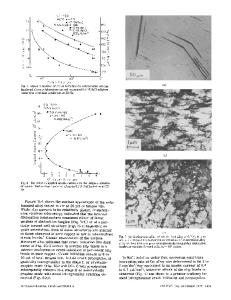Stress-life fatigue behavior and fracture-surface morphology of a Cu-based bulk-metallic glass
- PDF / 302,655 Bytes
- 8 Pages / 585 x 783 pts Page_size
- 74 Downloads / 298 Views
Q.S. Zhang and Z.Q. Hu Shenyang National Laboratory for Materials Science, Institute of Metal Research, Chinese Academy of Science, Shenyang 110016, PR China (Received 15 June 2006; accepted 4 October 2006)
The stress-life fatigue behavior and fracture morphology of a (Cu60Zr30Ti10)99Sn1 bulk-metallic glass alloy was investigated under both three-point and four-point bending conditions. For all stress levels tested, the fatigue lifetimes tended to be higher for the three-point loading condition. The fatigue endurance limits (defined as 107 cycles without failure), based on the applied stress range, for three-point and four-point loading conditions were approximately 475 MPa and 350 MPa, respectively. All fracture surfaces were found to be composed of four main regions: a crack-initiation site, a stable crack-growth region, an unstable fast-fracture region, and a melting region. Finely spaced parallel marks, similar to fatigue striations found in crystalline alloys, oriented somewhat perpendicular to the direction of crack propagation were observed in the stable crack-growth region. Analyses of these marks found that their spacing increased with increasing stress-intensity-factor range. Damage was found to initiate from preexisting defects present on or near the surface.
I. INTRODUCTION
Bulk-metallic glasses (BMGs) possess many attractive properties, such as high strengths, large elastic limits, high hardness, low coefficients of friction, high wear resistances, high corrosion resistances, and ease of forming and shaping. It is because of these attractive properties that BMGs are now being studied as potential candidates for a wide range of applications,1 such as golf clubs, precision mechanical elements, dental materials, and jewelry. Due to their inherent amorphous structure, BMGs do not possess any of the traditional notions of crystalline defects, such as dislocations or grain boundaries. Consequently, traditional deformation mechanisms associated with conventional crystalline alloys do not apply to BMGs. At low temperatures or high strain rates, BMGs deform inhomogeneously with deformation confined to narrow shear bands, which rapidly propagate until catastrophic failure. At high temperatures or low strain rates, BMGs deform more homogenously.2–4 Moreover, under
a)
Address all correspondence to this author. e-mail: [email protected] DOI: 10.1557/JMR.2007.0052 374 J. Mater. Res., Vol. 22, No. 2, Feb 2007 http://journals.cambridge.org Downloaded: 23 Mar 2015
tensile loading, BMGs display zero plasticity, whereas in compression, some ductility is observed.5 In crystalline alloys, fatigue damage can initiate along persistent slip bands, grain boundaries, or some other preexistent flaw (such as inclusions or gas pores).6 Recently, a number of studies have focused on the fatigue behavior of Zr-based BMGs.7–24 These studies have revealed that BMGs are susceptible to fatigue degradation. Shear localization occurs, which leads to the initiation of fatigue damage under cyclic loading. Crack-growth rates depend on the a
Data Loading...











